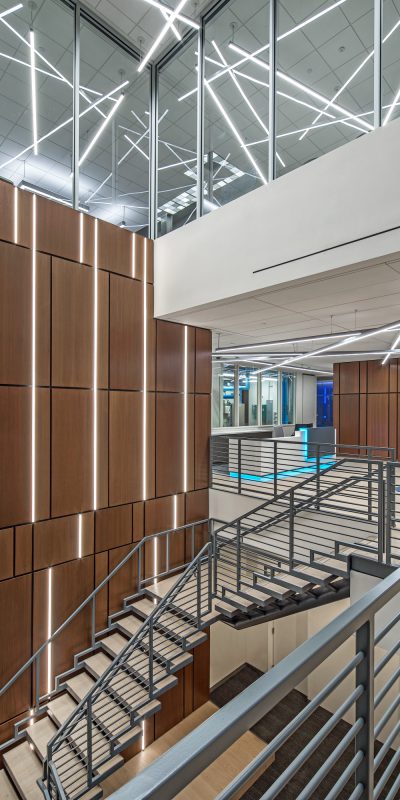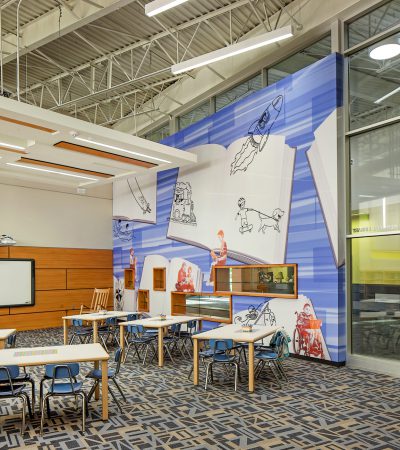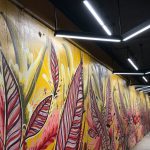Health in the Built Environment: With Sam Haberman
Did you know that humans spend upwards of 90% of our time indoors? This makes us the first indoor species. (1) You most likely have a newfound interest in the quality of health our indoor environments provide because of the COVID-19 pandemic, or maybe you have been gradually starting to notice the changes underway in the built environment since healthy building design began several years ago. At Alvine, we asked our healthy buildings guru, Samuel Haberman P.E., LC, about the ins and outs of indoor air, circadian rhythms, and what the future of the built environment looks like post-pandemic.
“We spend upwards of 90% of our time indoors.”
What makes a building “healthy”?
Isn’t that the golden goose question? The best definition I’ve settled on is that healthy buildings are not simply buildings that mitigate a specific disease; healthy buildings are a holistic approach to the built environment that enhances human health, wellness, and performance. In turn, this leads to a beneficial side effect of improved business performance. Simply, healthier occupants perform better. This increases a business’s opportunity for greater return on investment than, let’s say, simply reducing energy consumption with a “green building.”
Perhaps it’s due to seeing our peers in masks for almost a year, but it’s pretty clear that the air we breathe has a huge impact on our health. What is the future of “indoor air”?
Without a doubt, there has been an emphasis on improving outdoor air quality, cutting back on carbon fuel sources, and minimizing greenhouse gas emissions. Before COVID-19, there was little coverage on the need for eliminating indoor air pollutants, yet we spend most of our time indoors. I think the future of “indoor air” is twofold.
- Minimum acceptable industry standards and code requirements are not necessarily optimal occupant standards. Cutting edge technology isn’t needed to improve indoor air quality, only the need for a design team to identify indoor air as a major design criterion for a successful project.
- I think, one day, indoor air quality will be a human resource metric. Building occupants will expect a business to publish its indoor air metrics, and employees will weigh the decision of which companies to work for (and which apartments to live in) based upon the indoor air quality, among other wellness factors, in the building they would occupy.
Why should employers care about their employee’s circadian response?
While still fairly new research topics; lighting design and color spectrum have the potential to correct many wrongs that have been implemented in the modern design of buildings since the invention of electric lighting and HVAC systems. We know that our bodies are responding to visible light in non-visual ways. Our circadian rhythm is a 24-hour body clock regulating many bodily functions and uses visual light as a cue to sync this rhythm every day. Without sufficient, blue-enriched light during the day and with too much at night, our body clock can get out of sync. In our modern built environment, most people are exposed to light levels that are 4 to 13 times lower during the day and 35 to 45 times higher during the night than what’s ideal for our circadian response.
Why does it matter? Research shows it impacts wakefulness, sleep onset, endocrine physiology, core body temperature regulation, and cancer cell growth, among others. Some European countries have identified night shift work as a carcinogen and compensate night shift workers accordingly.
What’s been the biggest impact on you after diving deep into the topic of healthy building designs?
I will say, before this healthy building design effort and the pandemic, I was ignorant to the vast amount of research data and proven methods already out there on healthy building design. For me personally, as a kid I always liked math, I always liked to draw. Drawing house plans in junior high was fun, and architectural engineering was an easy career choice. But I never imagined having a career where, as a building engineer, I have the responsibility and privilege to design the environments people live and experience life in, which in turn impact their health and wellness…that’s profound. I’ve begun to shift my mindset that I design “indoor environments” not just ‘building systems.”
Where can I learn more?
Alvine has created a white paper for our clients, partners, and employees. You can download “Health in the Built Environment” here.
If you liked this article, take a look at, “How Does COVID-19 Challenge Future Engineering?”
Samuel Haberman P.E., LC is a licensed electrical engineer at Alvine with 14 years of experience. His passion for healthy buildings and improving the lives of those who use the systems he engineers enables him to design energy-efficient and innovative solutions. Sam is passionate about engaging project stakeholders to ensure that the owner’s vision is achieved. His notable projects include Folding Light: Oklahoma Contemporary Arts Center, OMNI Oklahoma City Hotel, BancFirst Tower Renovation, Four Partners Place on the University of Oklahoma campus, and the Oklahoma State Department of Wildlife Conservation Headquarters.
Works Cited
(1) Allen, Joseph G., and John D. Macomber. “We Spend 90% of Our Time inside-Why Don’t We Care That Indoor Air Is so Polluted?” Fast Company, Fast Company, 20 May 2020, www.fastcompany.com/90506856/we-spend-90-of-our-time-inside-why-dont-we-care-that-indoor-air-is-so-polluted?fbclid=IwAR19RUoIpcyWs1BXAWH_4zJYu77rH8PeQcFaNaQt2G_k6iSU-nl1khC06J8.






